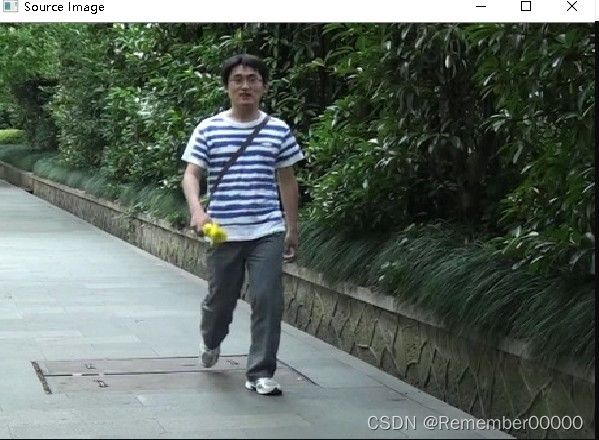数字图像1-opencv c++基本操作
数字图像1-opencv c++基本操作
实验题目: 实验1:图像基本操作
实验1.1:图像加载、显示
实验过程中遇到和解决的问题:
int Show_img() {
//读取图片
Mat src_img = imread(src_path, IMREAD_COLOR);
//确认图片不空
if (src_img.empty()) {
cout << "The image is empty!\n";
return EXIT_FAILURE;
}
//定义显示窗口(可省略, 这里可以设置窗口尺寸)
namedWindow(src_win, WINDOW_AUTOSIZE);
//显示图片
imshow(src_win, src_img);
//保持窗口始终存在
waitKey(0);
return 0;
}
-
路径不存在或者图片名称输入错误导致程序异常退出, 这时候添加图像的
.empty()处理这种报错, 有助于程序正常运行 -
imread(path,mode)mode可以选择多种, 用于显示灰度图,RGB图和RGBA图等, 后文显示RGBA图出现问题, 应该使用mode=IMREAD_UNCHANGED. -
waitkey(0)用于窗口的停留检测操纵, 使窗口停止. -
namedWindow(window_name,mode)mode用于显示窗口尺寸, 选择WINDOW_AUTOSIZE适应图片, 和可以选择矩形等
结果分析与体会:
jpg:
png
都正常显示.
实验1.2:图像通道分离
实验过程中遇到和解决的问题:
void getChannel(const uchar* input, int width, int height, int inStep, int inChannels, uchar*& output, int outStep, int channelToGet) {
//输出uchar数组 先设为较大的数组 防止溢出
uchar ans[N] = {0};
int poi = 0;//src_img对应的input指针指向访问位置
int cnt = 0;//ans中指针 用于指向存储位置
//图像交叉存储方式下访问每个像素的固定channel
for (int y = 0; y < height; y++) {
//考虑图像对齐填充下 每次找到a row的第一个位置
poi = channelToGet+y*inStep;
//cout <
//遍历一行像素的特定channel
for (int x = 0; x < width; x++) {
//poi += x * inChannels;
ans[cnt] = input[poi];
poi += inChannels;
//cout << y << "-" <<" x " << x << " poi " << poi << "\n";
cnt++;
}
}
//这种紧密存储方式下, 没有为了对齐填充, 所以step等于行像素值
outStep = width;
//ans.resize()
//输出output指针指向输出uchar ans[]
output = ans;
cout <<"getchannel "<<getChannel<<" value:"<<int(output[0])<<" get ok!\n";// << output;
}
-
uchar ans[N] 注意N不能使用图像width和height设定特定大小的数组, 因此要提前设定开辟固定大小的数组
注意数组不能太小, 否则会发生溢出, 而且溢出的报错不一定是在访问数组的时候报错, 我这里是在poi+到一定数值后报的错, 就导致找bug找了很长时间. 假设500x500都要开辟5e5大小的数组.
数值溢出异常:
-
poi指针先找到每一行的其实位置, 是为了应对交叉存储下的填充无用数值被读写
-
关于uchar和Mat的转换
//Mat转为uchar* const uchar* input = src_img.data; uchar* output=NULL; int outStep=0; getChannel(input, src_img.cols, src_img.rows, src_img.step, src_img.channels(), output, outStep, 2); //uchar*转为Mat Mat des_img(src_img.rows, src_img.cols, CV_8UC1, output);注意uchar是指向数组第一个位置的指针, 而且构造Mat允许指针
-
通道分离数值验证:
结果分析与体会:
通过RGB三个通道分离, 从左上, 右上, 左下,右下分别对应着原图, 分离通道BGR, 从绿色头发和红色头发, 可以看出明显的偏白(数值大)和偏黑(数值小), 表示通道提取正确.
实验1.3:图像合成
实验过程中遇到和解决的问题:
提取Alpha
void getAlpha(Mat& img) {
//创建大小相同的Mat
Mat ans = Mat::zeros(img.size(), CV_8UC1);
//每个像素提取第四通道
for (int x = 0; x < img.cols; x++) {
for (int y = 0; y < img.rows; y++) {
ans.at<uchar>(y, x) = img.at<Vec4b>(y, x)[3];
}
}
imshow("alpha", ans);
waitKey(0);
return;
}
- 首先图像读取imread中要用四channel方式读取.
- 读取每个像素的第四通道, 使用
img.at这种方式. 使用Vec3b则没有第四通道并且会造成图片访问异常.(y, x)[3]
Alpha混合 更换背景
void changeBackground(Mat& src_img) {
//读取背景图片
string bg_path = "D:\\CV\\IP_data\\background.jpg";
Mat bg_img = imread(bg_path);
//背景混合图片
Mat ans_img = Mat::zeros(src_img.size(), src_img.type());
cout << ans_img.channels() << "\n";
//对于任意大小背景的图片 更换为目标图片的尺寸
resize(bg_img, bg_img, src_img.size());
imshow("bg_img", bg_img);
waitKey(0);
cout << "bg_img.size:" << bg_img.size() << "ans_img.size:" << ans_img.size() << "\n";
int cal_val = 0;
for (int x = 0; x < src_img.cols; x++) {
for (int y = 0; y < src_img.rows; y++) {
int alpha = src_img.at<Vec4b>(y, x)[3];
for (int ch = 0; ch < 3; ch++) {
//alpha混合公式
cal_val = src_img.at<Vec4b>(y, x)[ch] * (float(alpha) / 255.0) + bg_img.at<Vec3b>(y, x)[ch] * ((255.0 - float(alpha)) / 255.0);
//防止数据溢出 等效于saturate_cast
if (cal_val > 255) cal_val = 255;
ans_img.at<Vec4b>(y, x)[ch] = cal_val;
}
}
}
//namedWindow("after",)
imshow("after", ans_img);
waitKey(0);
return;
}
-
对于任意大小的背景需要处理背景大小, 使用
resize函数处理成前景大小 -
混合公式为:
color = (A.rgb * A.a) + (B.rgb * (1 - A.a)) -
error问题主要在细节上, 含有alpha的图像不能使用Vec3b访问, 会根本访问不出来.
-
防止数据溢出等效于函数
saturate_cast
结果分析与体会:
alpha通道显示:
[外链图片转存失败,源站可能有防盗链机制,建议将图片保存下来直接上传(img-kx91yrOv-1663552229430)(%E5%B1%B1%E4%B8%9C%E5%A4%A7%E5%AD%A6%E6%95%B0%E5%AD%97%E5%9B%BE%E5%83%8F%E5%A4%84%E7%90%86%E5%AE%9E%E9%AA%8C%E6%8A%A5%E5%91%8A1.assets/Snipaste_2022-09-18_23-21-22.jpg)]
alpha表示不透明度, 可以看到笔筒的不同位置有不同的透明度, 实体小玩具基本是完全不透明和完全透明.
alpha混合
- 可以看到笔筒的某些位置是悲情和前景的融合, 某些位置是单纯的前景, 可见通过alpha混合能够得到相对比较好的混合结果.
代码
#include
//遍历一行像素的特定channel
for (int x = 0; x < width; x++) {
//poi += x * inChannels;
ans[cnt] = input[poi];
poi += inChannels;
//cout << y << "-" <<" x " << x << " poi " << poi << "\n";
cnt++;
}
}
//这种紧密存储方式下, 没有为了对齐填充, 所以step等于行像素值
outStep = width;
//ans.resize()
//输出output指针指向输出uchar ans[]
output = ans;
cout <<"getchannel "<<getChannel<<" value:"<<int(output[0])<<" get ok!\n";// << output;
}
void getAlpha(Mat& img) {
//创建大小相同的Mat
Mat ans = Mat::zeros(img.size(), CV_8UC1);
//每个像素提取第四通道
for (int x = 0; x < img.cols; x++) {
for (int y = 0; y < img.rows; y++) {
ans.at<uchar>(y, x) = img.at<Vec4b>(y, x)[3];
}
}
imshow("alpha", ans);
waitKey(0);
return;
}
void changeBackground(Mat& src_img) {
//读取背景图片
string bg_path = "D:\\CV\\IP_data\\background.jpg";
Mat bg_img = imread(bg_path);
//背景混合图片
Mat ans_img = Mat::zeros(src_img.size(), src_img.type());
cout << ans_img.channels() << "\n";
//对于任意大小背景的图片 更换为目标图片的尺寸
resize(bg_img, bg_img, src_img.size());
imshow("bg_img", bg_img);
waitKey(0);
cout << "bg_img.size:" << bg_img.size() << "ans_img.size:" << ans_img.size() << "\n";
int cal_val = 0;
for (int x = 0; x < src_img.cols; x++) {
for (int y = 0; y < src_img.rows; y++) {
int alpha = src_img.at<Vec4b>(y, x)[3];
for (int ch = 0; ch < 3; ch++) {
//alpha混合公式
cal_val = src_img.at<Vec4b>(y, x)[ch] * (float(alpha) / 255.0) + bg_img.at<Vec3b>(y, x)[ch] * ((255.0 - float(alpha)) / 255.0);
//防止数据溢出 等效于saturate_cast
if (cal_val > 255) cal_val = 255;
ans_img.at<Vec4b>(y, x)[ch] = cal_val;
}
}
}
//namedWindow("after",)
imshow("after", ans_img);
waitKey(0);
return;
}
int main(int argc, char** argv) {
//Show_img();
Mat src_img = imread(src_path, IMREAD_UNCHANGED);
//cout << src_img.channels();
cout << src_img.cols << 'x' << src_img.rows << " step: " << src_img.step << "\n";
imshow("test", src_img);
waitKey(0);
//getChannel 任意读取通道
//Mat转为uchar*
const uchar* input = src_img.data;
uchar* output=NULL;
int outStep=0;
getChannel(input, src_img.cols, src_img.rows, src_img.step, src_img.channels(), output, outStep, 2);
//uchar*转为Mat
Mat des_img(src_img.rows, src_img.cols, CV_8UC1, output);
//cout << output << endl;
cout << des_img.cols << 'x' << des_img.rows << " step: " << des_img.step << "\n";
namedWindow("des", WINDOW_AUTOSIZE);
imshow("des", des_img);
waitKey(0);
//getchannel---------end
//cout <<"===="<(0, 570)[0];
//得到alpha
// getAlpha(src_img);
//图像更换背景
// changeBackground(src_img);
return 0;
}








